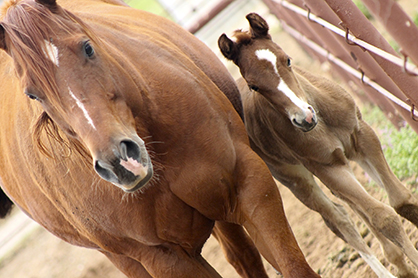Mare Obesity Impacts Foal Health and Osteochondrosis
Obesity contributes to insulin resistance, metabolic syndrome, laminitis, altered hormonal function of adipose tissue, low-grade inflammation, and decreased athletic performance in horses. In particular, obese mares produce foals with increased risk for low-grade inflammation and osteochondrosis (OC), according to European researchers.*
“Obesity continues to rise, at least in part, because many horses are now viewed as pets rather than athletes. Studies* show that owners consistently underestimate their horse’s true body condition, making it difficult to recognize overweight or obese horses and manage them appropriately,” explained Kathleen Crandell, Ph.D., a Kentucky Equine Researchnutritionist.
European researchers recently explored how mare obesity at time of artificial insemination impacted foals up to 18 months of age. Obesity in that study was measured using a five-point body condition score (BCS) scale rather than the Henneke nine-point scale, in which mares were considered obese with a BCS ≥4 but normal if the BCS was <4. Mares were maintained at those BSCs throughout the duration of the study.
Key findings of the study included:
- Serum amyloid A (SAA) levels, a measure of inflammation, was elevated in obese mares at the time of parturition, whereas SAA was normal in nonobese mares;
- No difference in the foals’ postnatal growth was observed between the two groups of mares; however, elevated SAA levels were measured in foals from obese mares from birth until 6 months of age;
- Foals from obese mares were more insulin resistant than foals from nonobese mares; and
- Significantly more foals from obese mares were diagnosed with OC. Specifically, 7 of 13 foals from obese mares had OC compared with only 1 of 10 foals from nonobese mares.
“Together, these evidence-based research efforts highlight the need to maintain an appropriate BCS in all horses, especially pregnant mares, as a less-than-ideal maternal environment can impact the long-term health of the foal,” summarized Crandell.
A successful weight loss program typical involves both caloric restriction and exercise. Need help determining what an appropriate diet is for your horse? Contact a Kentucky Equine Research nutrition consultant.
“A nutritionist can help determine what amount of forage should be offered and whether a vitamin and mineral supplement, such as Micro-Max from KER, might be indicated,” Crandell said.
In Australia, look for Gold Pellet, Nutrequin, or Perform.
*Robles, M., E. Nouveau, C. Gautier, et al. 2018. Maternal obesity increases insulin resistance, low-grade inflammation and osteochondrosis lesions in foals and yearlings until 18 months of age. PLoS One. 13(1):e0190309.
**Potter, S.J., N.J. Bamford, P.A. Harris, et al. 2016. Prevalence of obesity and owners’ perceptions of body condition in pleasure horses and ponies in south-eastern Australia. Australian Veterinary Journal. 94(11):427-432.
Article reprinted courtesy of Kentucky Equine Research (KER). Visit equinews.com for the latest in equine nutrition and management, and subscribe to The Weekly Feed to receive these articles directly (equinews.com/newsletters).











